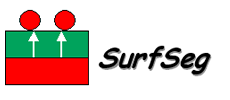金属偏析予測システム (SurfSeg)
Segregation is a phenomenon that one of components of a material has higher concentration at surface or interface of a material than in a bulk or film.
When a component segregates at the surface (surface segregation), many surface-relating properties such as wear, friction, corrosion, catalytic function and electron emission would be altered.
When a component segregates at the interface (interface segregation), many interface-relating properties such as adhesion, interface reaction and electric contact (Shottky barrier height) would be influenced. SurfSeg is designed to simulate surface or interface segregation in the following four cases (at the time of April 2009, only the first one is available). Materials are approximated as a uniform media, therefore, the crystal orientation dependence of physical properties relating to the segregation is not taken into account for the simulation. surface segregation in film/substrate system (available from April 2009)
- surface segregation in film/substrate system (available from April 2009) Segregation of substrate atoms on the surface of a film is predicted by comparing the adsorption energy of a substrate atom on film material with that on substrate material. The principle of simulation is explained in more detail in the literature [Michiko Yoshitake, Yarrama-Reddy Aparna, and Kazuhiro Yoshihara, J. Vac. Sci. Technol., A 19, 2001, pp. 1432-1437.]
- surface segregation in dilute alloy system (available from January 2023) The principle of simulation is explained in the literature [Michiko Yoshitake, 10.51094/jxiv.297]
- interface segregation at film-substrate interface (available from January 2023) The principle of simulation is explained in the literature [Michiko Yoshitake, Yarrama-Reddy Aparna, and Kazuhiro Yoshihara, J. Vac. Sci. Technol., A 19, 2001, 2612-2616.]
- interface segregation at alloy-substrate interface (available from January 2023) The principle of simulation is explained in the literature [Michiko Yoshitake, 10.51094/jxiv.297]
The principle of simulation UNDER OXYGEN ATMOSPHERE (available from August 2012) is explained in the literature [Michiko Yoshitake, Jpn. J. Appl. Phys., 51, 2012, 085601.]
初めての方へ
MatNaviのご利用にあたっては、「DICEアカウントのユーザ登録」「メールアドレスのドメイン登録」「サービスの利用申請」が必要です。詳しくはこちら(リンク)をご確認ください。
データの大量ダウンロードは禁止
データのウェブスクレイピングは禁止です!
手動や機械的な方法を問わず、まとまったデータ量の取得はMatNaviサービス利用約款により禁止されています。
違反と認められるデータアクセスの可能性があるとき、ユーザアカウントを停止します。
MatNaviデータベースのサービスが存続できなくなりますので、利用約款の順守をお願いします。
データベースの引用について
論文等において本データベースを引用する場合は、以下の方法により引用してください。
●参考論文を記載する
Yoshitake, M. (2023) Free software for general prediction of surface and interface segregation: SurfSeg - updated. https://doi.org/10.51094/jxiv.297
●データベースのURLを記載する
[その他の引用論文リスト]
(例)金属偏析予測システム: https://surfseg.nims.go.jp/ 物質・材料研究機構(NIMS)、アクセスした日付
SurfSeg: https://surfseg.nims.go.jp/ National Institute for Materials Science (NIMS), accessed {date-of-your-access}.
関連:謝辞の記載方法
注意事項
- このデータベースシステムの著作権は,国立研究開発法人物質・材料研究機構(NIMS)にあります。
- このデータベースシステムをNIMSに無断で転載、複製、第三者へ配布することを禁止します。
- このデータベースシステムの使用により使用者が被ったいかなる損害に対しても、NIMSは一切の責任を負いません。
必須環境
対応ブラウザ:Microsoft Edge、Google Chrome、Firefox


